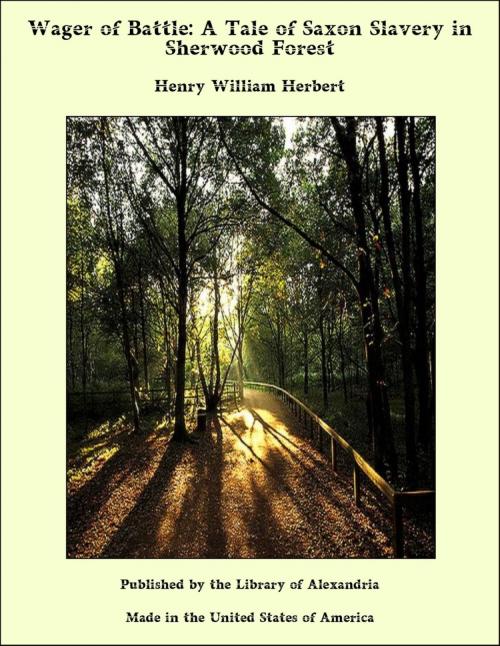Wager of Battle: A Tale of Saxon Slavery in Sherwood Forest
Nonfiction, Religion & Spirituality, New Age, History, Fiction & Literature| Author: | Henry William Herbert | ISBN: | 9781465620156 |
| Publisher: | Library of Alexandria | Publication: | March 8, 2015 |
| Imprint: | Language: | English |
| Author: | Henry William Herbert |
| ISBN: | 9781465620156 |
| Publisher: | Library of Alexandria |
| Publication: | March 8, 2015 |
| Imprint: | |
| Language: | English |
In the latter part of the twelfth century—when, in the reign of Henry II., fourth successor of the Conqueror, and grandson of the first prince of that name, known as Beauclerc, the condition of the vanquished Saxons had begun in some sort to amend, though no fusion of the races had as yet commenced, and tranquillity was partially restored to England—the greater part of the northern counties, from the Trent to the mouths of Tyne and Solway, was little better than an unbroken chase or forest, with the exception of the fiefs of a few great barons, or the territories of a few cities and free borough towns; and thence, northward to the Scottish frontier, all was a rude and pathless desert of morasses, moors, and mountains, untrodden save by the foot of the persecuted Saxon outlaw. In the West and North Ridings of the great and important Shire of York, there were, it is true, already a few towns of more than growing importance; several of which had been originally the sites, or had grown up in the vicinity and under the shelter of Roman Stative encampments; whereof not a few of them have retained the evidence in their common termination, caster, while others yet retain the more modern Saxon appellations. Of these two classes, Doncaster, Pontefract, Rotherham, Sheffield, Ripon, may be taken as examples, which were even then flourishing, and, for the times, even opulent manufacturing boroughs, while the vastly larger and more wealthy commercial places, which have since sprung up, mushroom-like, around them, had then neither hearths nor homes, names nor existence. In addition to these, many great lords and powerful barons already possessed vast demesnes and manors, and had erected almost royal fortalices, the venerable ruins of which still bear evidence to the power and the martial spirit of the Norman lords of England; and even more majestic and more richly endowed institutions of the church, such as Fountains, Jorvaulx, and Bolton Abbayes, still the wonder and reproach of modern architecture, and the admiration of modern artists, had created around themselves garden-like oases among the green glades and grassy aisles of the immemorial British forests; while, emulating the example of their feudal or clerical superiors, many a military tenant, many a gray-frocked friar, had reared his tower of strength, or built his lonely cell, upon some moat-surrounded mount, or in some bosky dingle of the wood. In the East Riding, all to the north of the ancient city of the Shire, even then famous for its minster and its castle, even then the see and palace of the second archbishop of the realm, was wilder yet, ruder and more uncivilized. Even to this day, it is, comparatively speaking, a bleak and barren region, overswept by the cold gusts from the German ocean, abounding more in dark and stormy wolds than in the cheerful green of copse or wildwood, rejoicing little in pasture, less in tillage, and boasting of nothing superior to the dull market towns of the interior, and the small fishing villages nested among the crags of its iron coast.
In the latter part of the twelfth century—when, in the reign of Henry II., fourth successor of the Conqueror, and grandson of the first prince of that name, known as Beauclerc, the condition of the vanquished Saxons had begun in some sort to amend, though no fusion of the races had as yet commenced, and tranquillity was partially restored to England—the greater part of the northern counties, from the Trent to the mouths of Tyne and Solway, was little better than an unbroken chase or forest, with the exception of the fiefs of a few great barons, or the territories of a few cities and free borough towns; and thence, northward to the Scottish frontier, all was a rude and pathless desert of morasses, moors, and mountains, untrodden save by the foot of the persecuted Saxon outlaw. In the West and North Ridings of the great and important Shire of York, there were, it is true, already a few towns of more than growing importance; several of which had been originally the sites, or had grown up in the vicinity and under the shelter of Roman Stative encampments; whereof not a few of them have retained the evidence in their common termination, caster, while others yet retain the more modern Saxon appellations. Of these two classes, Doncaster, Pontefract, Rotherham, Sheffield, Ripon, may be taken as examples, which were even then flourishing, and, for the times, even opulent manufacturing boroughs, while the vastly larger and more wealthy commercial places, which have since sprung up, mushroom-like, around them, had then neither hearths nor homes, names nor existence. In addition to these, many great lords and powerful barons already possessed vast demesnes and manors, and had erected almost royal fortalices, the venerable ruins of which still bear evidence to the power and the martial spirit of the Norman lords of England; and even more majestic and more richly endowed institutions of the church, such as Fountains, Jorvaulx, and Bolton Abbayes, still the wonder and reproach of modern architecture, and the admiration of modern artists, had created around themselves garden-like oases among the green glades and grassy aisles of the immemorial British forests; while, emulating the example of their feudal or clerical superiors, many a military tenant, many a gray-frocked friar, had reared his tower of strength, or built his lonely cell, upon some moat-surrounded mount, or in some bosky dingle of the wood. In the East Riding, all to the north of the ancient city of the Shire, even then famous for its minster and its castle, even then the see and palace of the second archbishop of the realm, was wilder yet, ruder and more uncivilized. Even to this day, it is, comparatively speaking, a bleak and barren region, overswept by the cold gusts from the German ocean, abounding more in dark and stormy wolds than in the cheerful green of copse or wildwood, rejoicing little in pasture, less in tillage, and boasting of nothing superior to the dull market towns of the interior, and the small fishing villages nested among the crags of its iron coast.















